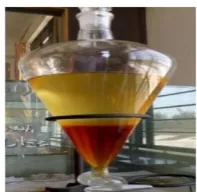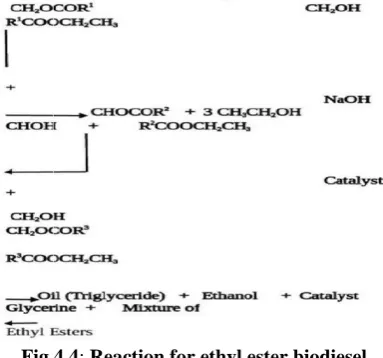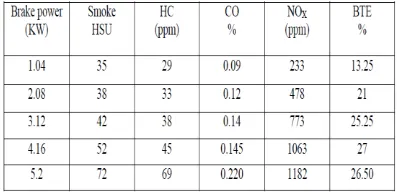84
Performance Test on 4-Stroke Single Cylinder Diesel
Engine Using Diesel Blended With Corn Ethanol as a
Fuel
NAGESH S B1Dr.SRIDHAR S2
1
Assistant professor , Mechanical Engineering, CIT Gubbi.2Associate professor Mechanical Engineering, CIT Gubbi,
ABSTRACT
The extensive use of petroleum products as a fuel for engines results in global warming due to greenhouse emissions. As the sources of fuels such as diesel and petroleum are said to be in shortage in a couple of years and also increase in the price of petroleum products has grabbed the attention towards alternate fuel. And bio diesel is one among such alternate fuels. Bio diesel is a fuel that is generated from animal fat or vegetable oil. It is renewable energy source since agriculture is the main source. The main advantage of using bio diesel as a fuel is, it reduces the greenhouse effect by reducing carbon di-oxide released during burning which results in the reduction of global warming. In this study we are producing bio diesel using corn oil by transesterification process. And we are conducting a performance test of 4-stroke single cylinder diesel engine using 10%, 20% and 100% (i.e. B10, B20 and B100) of corn bio diesel. And comparing the performance results with the performance results obtained using only diesel as a fuel.
Keywords: Biodiesel,petroleum, transesterification, B10, B20 and B100.
1. INTRODUCTION
Alternate fuels are known by non-conventional fuels. These can be used as substituent fuel for Internal combustion engines. The increased use of petroleum product leads to increase in release of CO2 and other pollutants from the engines using petrol or diesel as a fuel to the environment resulted in global warming and pollution. Therefore, the search for an alternative fuel became important and the tests on bio diesel as an alternate fuel grabbed the attention of the government also. Rudolf Diesel who invented diesel engine said that "The usage of vegetable oil in future will become important like bio diesel fuel" [1] in 1912 Missouri engineering conference. Biofuels can be used to meet increasing demands of conventional energy sources [2]Corn grain is heavily used in U.S. for bio fuel production[3].At a very low cost it is produced compared to other biomass in US .Dry grind process is the most commonly used method to extract fuel ethanol from corn.
1.1 CHARACTERSTICS OF BIO DIESEL
We know that, the diesel molecule is made up of 15 carbon chain molecule. And study showed that vegetable oil has around 14 to 17 carbon chain molecule which approximately equal to carbon number in conventional diesel fuel. Therefore bio diesel is the best alternate fuel which is obtained by processing the vegetable oil. Since it has low sulphur content, it results in very less emission of sulphur di oxide and sulphides and also aromatic hydrocarbons are absent in bio diesel, whose emission affects the human body. When compared to conventional diesel biodiesel can reduce around 90%, rate of cancer is reduced by 94% and emission of carbon monoxide is reduced by 10%. It has good lubrication property which reduces the wear rate of engine components and increases its service life. It can be transported, stored and used safely because of high flash point. Since it has higher hexadecane value, it results in better combustion than conventional diesel. Biodiesel is different from other oil reserves because of its renewable performance. Due these excellent characteristics it satisfies the standards of Europe II and other strict emission standards. The emission of carbon di oxide is less than the amount of carbon-di-oxide consumed by the plants during photosynthesis results in reduction of greenhouse effect which in turn reduces global warming.
2. ESTER
Ester is s chemical compound that is derived from an organic or inorganic acid in which at least hydroxyl(-OH) is replaced by an alkyl group (-o-) group.
85
2.1 ESTERIFICATIONCarboxylic acid esters formula RCOOR' (where, R and R' are any organic combining groups), that are commonlyprepared by reaction of carboxylic acids and alcohols in the presence of hydrochloric acid or sulphuric acid and this process is known as Esterification.
3. TRANSESTERIFICATION
R' of an alcohol. These Transesterification [4] is the process of exchanging the organic group R'' of an ester with organic group reactions are often catalysed by the addition of an acid or base catalyst. The reaction can also be accomplished with the help of enzymes (biocatalysts) particularly lipase.
Strong acids catalyse the reaction by donating a proton to the carbonyl group, thus making it more potent electrophile, whereas bases catalyse the reaction by removing a proton from the alcohol, thus making it more nucleophilic. Esters with larger alkoxy groups can made from methyl to ethyl esters in high purity by heating the mixture of ester, acid/base, and large alcohol and evaporating the small alcohol to drive equilibrium.
4. BIODIESEL PRODUCTION
4.1 CORN ETHYL ESTER (BIODIESEL)
In order to blend corn oil with the diesel, first it should be converted to biodiesel by transesterification process. We know that the corn oil are made up of long chain fatty acids if we treat it with ethanol andNaOH,due to transesterification we will get corn ethyl ester (i.e. biodiesel) and glycerol as a by-product [5].
4.2 PROCEDURE TO GET BIODIESEL FROM CORN OIL
This process is carried out using ethanol as an alcohol and sodium hydroxide (NaOH) as a catalyst. And the amount used is, ethanol/oil molar ratio of 4.5:1 and that of catalyst is 0.5% (wt. / wt. of oil) NaOH.
Step 1: We have to measure exact 500 ml of corn oil and it is heated to 110 °C in order to remove moisture present in the corn oil. Then it is poured in to the vessel which is preheated (70 °C) and it is kept on the temperature controlled, hot plate magnetic stirrer which is maintained at 50 °C.
Step 2: After heating we have to prepare a fresh solution of ethanol (110 ml) and sodium hydroxide (4 g). Step 3: we have to add the freshly prepared solution into the vessel kept on the hot plate magnetic stirrer which is maintained at 50 oC, this moment is considered as the time zero of the reaction.
Step 4: The mixture of oil and freshly added solution is kept stirring at 50 °C for 30 minutes. And the mixture gradually changes its colour from pale yellow to reddish brown, this indicates the completion of the transesterification.
Step 5: After the reaction the oil is transferred to separating flask and allow it to settle down. After this two distinct phases are formed. The upper one is of ethyl ester and the lower one is of glycerine.
[image:2.595.248.347.525.621.2]
Fig 4.1: Distinct phase formation after reaction.
Step 6: The glycerol is separated by sedimentation. The removal of catalyst is done by washing with lukewarm distilled water till the wash water becomes clear, after that the water present is removed by heating. And the final product obtained is bio diesel.
For washing the amount of distilled water used is same as the amount of the ethyl ester collected, this is because for uniform washing. In figure 5.2 the upper phase layer is ethyl ester and the lower layer is lukewarm distilled water. The whitish layer between ethyl ester and distilled water is NaOH.
86
Fig 4.2: Washing of biodiesel. Fig 4.3:Clear distilled water. [image:3.595.199.391.266.445.2]The figure 4.4 shows chemical process for ethyl ester biodiesel the reaction between oil and alcohol is a reversible reaction. So, the alcohol must be added in excess in order to drive the reaction towards right and ensure complete reaction.
Fig 4.4: Reaction for ethyl ester biodiesel.
4.3 CHARACTERISTICS OF CORN ETHYL ESTER (BIODIESEL)
[image:3.595.195.400.513.657.2]
Table 4.1: Properties of different blends.
5. EXPERIMENTAL PROCEDURE
Step 1: Take bio diesel blend say ethyl ester B10, the composition contains 100 ml of ethyl ester and 900 ml of diesel and 2% of additive span 80 (Sorbitanmonooleate)
Step 2: Load to be added to engine and increased simultaneously with the help of the electrical loading and the mean difference of the two gauges are calculated to fine the exact torque applied on engine. Loads are added in ascending order. The adding of load the rpm of the engine will be changing simultaneously that will be displayed on the digital meter. All this testing will give the performance of the fuel used in the engine and will be used in calculating to find the brake power and break thermal efficiency of the engine.
Properties Diesel B100 B10 B20 Density(kg/m3) 840 894 870 880
Calorific value(kj/kg)
43000 38204 39500 39000
Visosity Mm2/s
3.0 4.0 3.90 3.97
Pour poin(oC) -33 -30 Cloud
point(oC)
-16 -15
87
Step 3: The temperature rise in the engine will noted with help of thermocouples placed inside the engine and the time taken in seconds for consumption of 25cc of fuel will be calculated with help of stop watch The readings for the gauge and temperature indicators are tabulated, with help of these readings the work done by the engine is calculated. and the fuels efficiency is calculated with help of calculating the following:1. Brake power
2. Specific fuel consumption 3. Brake thermal efficiency 4. Indicated Power
5. Mechanical efficiency
Different graphs are plotted to find the effectiveness of specimen fuel and there consistency on the engine working.
5.1CALCULATIONS At BP =1.04 KW
1. Mass of fuel consumed per second (mf) mf = (25x10-6 x diesel) / (time) = (25x10-6 x 840) / (138.8)
mf = 1.52x10-4 2. Brake Power BP = mf x (BTH x Cv)
= 1.52x10-4 x (0.16 x 43000) BP = 1.04 KW
3. Mass of air consumed per second (ma) ma = (air) x A x velocity = (air) x [/4 x d2] x Cd (2𝑔 × ℎa)
= 1.1 x [/4 (0.02)2] x 0.62 (2 × 9.81 × 69.09) ma = 7.88x10-3 Kg/s
4. Total fuel consumption (TFC) TFC = mf x 3600
= 1.512x10-4 x 3600
TFC = 0.544 Kg/hr m = 75% where, FP= Friction power 5. Specific fuel consumption (SFC)
SFC = TFC / BP = 0.544 / 1.04 SFC = 0.523 Kg/ KW-hr 6. A/F ratio
ma/ mf = 7.88x10-3/1512x10-4 ma/ mf = 52.12
7. Indicated Power (IP) IP = BP+FP = 1.04 + 0.3466
IP = 1.3866 KW
8. Mechanical efficiency (m) m = (BP / IP) x 100
=(1.04/1.3866)*100 =75%
Tabular column
88
Table 5.1.3: Smoke CO, HC & NOx readings for B10 Table 5.1.4:Smoke CO, HC & NOx readings for B20Fig 5.1: Comparing diesel, B10, B20 & B100 w.r.t. Figure 5.2: Comparing diesel, B10, B20 & B100 Brake Thermal Efficiency. w.r.t NOX produced
In figure: 5.1 we can see that the brake thermal efficiency of the engine decreases as the percentage of the biodiesel increases in the diesel. This is because when compared to diesel the viscosity and density of the biodiesel is more and hence the brake thermal efficiency of the engine decreases as the percentage of the biodiesel increases in the diesel. When compared to B10 and B100 the brake thermal efficiency of the B20 is more. This is because of higher peak pressure and higher heat release rates when compared to B10 and B100. This is recorded actual data and there are many reasons for this like better or improved combustion, homogeneous air fuel mixing etc.
In figure 5.2: we can see that the percentage of NOx produced by the engine decreases gradually as the percentage of the biodiesel increases in diesel. This is because, compared to diesel biodiesel blends have lower energy content this reduces the brake thermal efficiency of the engine and hence NOx is also reduced. The percentage reduction of NOx produced by the engine for B10, B20 and B100 are 10%, 8% and 12% respectively.
6 EXHAUST GAS RECIRCULATION (EGR)
EGR is a method used to reduce nitrogen oxide emission in petrol and diesel engines. Engine exhaust gas is recirculating to the engine cylinders in order to reduce emission.
[image:5.595.72.524.279.380.2]89
Fig 6.1: NOx produced by B20 with & without EGR.The figure: 6.1 shows the reduction in amount of NOx produced engine for B20 with and without EGR. By incorporating 10% of EGR we can reduce up to 7% - 8% of NOx produced for the same fuel.
7 CONCLUSION
By comparing the experimental values with the diesel engine, we can conclude that
1.
Corn oil blend can be used as an alternate fuel for diesel engine2.
NOX emission can be reduced by using EGR method in diesel engine3.
B20 blend gives more brake thermal efficiency out of all the three blends.REFERENCES
[1] B.T. Naik. (2016). Performance Test on Diesel Engine with Biodiesel Blend Mixture. AIJREAS.1(12),146- JJMIE. 6 (2), 146-153.153
[2] M. Al-Hassana, H. Mujafeta and M. Al Shannagb. (2012). An Experimental Study on the Solubility of a Diesel-Ethanol Blend and on the Performance of a Diesel Engine Fueled with Diesel- Biodiesel - Ethanol Blends.
[3] B.T. Naik. [4] studied performance of diesel engine with biodiesel blend mixture. In his study he had mentioned about the history of biodiesel. In 1911, at the world’s fair in Paris, Rudolph ran his engine on pea nut oil and later described that “The diesel engine can be fed with vegetable oils and will help considerably in the development of agriculture of the countries which use it.
[4] H.B. Parikh, V.M. Prajapathi, K.H. Thakkar. (2013). Performance evaluation and emission analysis of 4-S engine using ethanol bio-diesel blended with diesel fuel. IJRET. 2 (4), 465-469.
[5] .Dr. Ashok Sharma1, Dr.Sarita Sharma1, Dr. Sanjay Verma, Mr. Rahul Bhargava. (2016). "Production of Bio fuel (Ethanol) from Corn and co product evolution": A Review. IRJET. 3 (12), 745-749.


